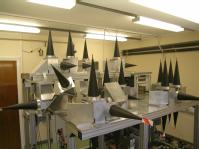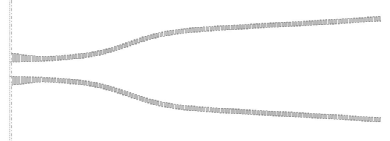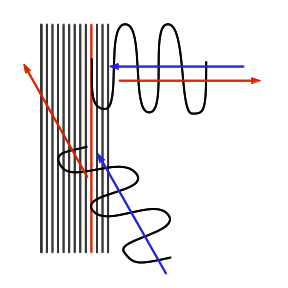Quasi-optical components for EPR
When we think about transmitting a radio frequency (RF) EM wave between a transmitter and an antenna we normally think about coaxial transmission lines or even waveguides. But at frequencies of around 100GHz and higher, particularly in the millimeter wave regime, waveguides begin to become lossy and have a limited bandwidth where they perform well. To overcome this a technique called quasi optics is employed.
 |
|
Quasi optical table on HiPER spectrometer |
High field EPR has meant that operating spectrometers at frequencies well above 10GHz (X-band) in the 100GHz (W-band) range has become common place, and an important component of these high field spectrometers has been quasi optical signal processing.
Quasi optics use free-space beams and optical components to transmit and process the waves in place of waveguide and waveguide components such as circulators and isolators. One of the important considerations we have to make, however, is that unlike conventional optics the wavelength is now comparable to the beam width, and this will have an effect diffraction. For this reason we use Gaussian beam modes to describe the free space beams, and the lowest order mode is called the fundamental mode.
|
|
| Corrugated horn antenna for high efficiency coupling to the fundamental free space gaussian mode |
The most important component in a quasi optical system is the antenna which we use to launch the beam from signal source and couple it back to our receiver. For this we use feed horn antennas which essentially converts the waves propagating within the waveguide into a freespace beam which is as close to the fundamental gaussian as possible, and the reciprocal case for receiving. The feedhorn which has the best performance for this purpose is the corrugated feed horn, which unlike traditional smooth wall feedhorns have a surface with has had a corrugated surface etched into it. The purpose of this is to improve the conversion between the waveguide modes and the fundamental freespace mode, with modern designs achieving conversion efficiencies close to 100%. This means that the beam in freespace will propagate with similar properties and reciprocal coupling at the receiver will be as efficient as possible.
|
|
| Wire grid polariser where the incident beam with E field parallel to the wires is reflected and the perpendicular beam passes |
But to successfuly use these quasi optical solutions in our spectrometers we need to have equivalents for the required signal processing components. These include circulators for isolating our transmitters and receivers and methods of selectively passing chosen polarisations. To achieve the circulator components Faraday rotators are empolyed. These operate by using the Faraday effect which rotates the polarisation of an input beam by an angle which depends on the birefringent properties of the rotator. If the same beam was reflected and passed back through the rotator it would not be simply rotated back to its input polarisation but instead rotated again, and this leads to its application in a quasi optical circulator. Another important component for quasi optical systems is the polariser and this is made of a series of parallel metal wires spaces out to that they make a grid. When the beam is incident with the E field parallel to the wires they act like a reflector because they can conduct, however, when the E field is perpendicular there are breaks in the conducting surface due to the gaps and there is no reflection set up by the wires.
Quasi optics is core to high performance high field EPR spectrometers due to the performance in tranmission and of all the components which are used. The transmission losses in such a system is far lower than an equivalent waveguide based system giving vast improvements in both the power we can deliver to the sample and the strength of the return signal which we see at our receiver.
References
Goldsmith, P.F. and IEEE Microwave Theory and Techniques Society., Quasioptical systems : Gaussian beam quasioptical propagation and applications. IEEE Press/Chapman & Hall Publishers series on microwave technology and RF. 1998, Piscataway, NJ: IEEE Press. xvii, 412 p.
Hunter, R. I., Robertson, D. A., Goy, P., Smith, G. M., "Design of high-performance millimeter wave and sub-millimeter wave quasi-optical isolators and circulators", IEEE Trans. Microwave Theory and Techniques, 55 (5) pp 890 - 898, 2007.
Scot's Guide to Electronics, J. C. G. Lesurf, http://www.st-andrews.ac.uk/~jcgl/Scots_Guide
Thomas Keating Ltd http://www.terahertz.co.uk

